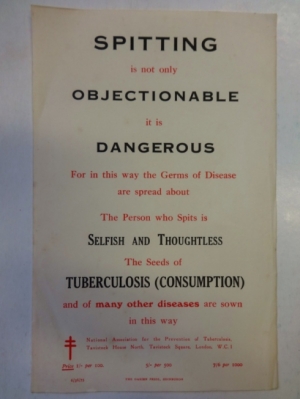"Above all, DO NOT SPIT. It is an unpleasant habit; but, more important, it is a dangerous one. Sputum is one of the most potent sources of infection: even a report that it is negative is not enough, for it may become positive at any time."
Excerpt from a ‘Good Luck' pamphlet made available by the National Association for the Prevention of Tuberculosis (NAPT) for patients leaving the Sanatorium.

Robert Koch's 1882 discovery of the Tuberculosis bacillus drove the modern understanding of tuberculosis as a contagious disease. Vaccination did follow fairly swiftly, but misadministration in 1927 delayed its widespread acceptance. So in the intervening period, and shortly after, the focus was on preventing the spread of tuberculosis (TB).
‘Do not spit' became a well recognised mantra and campaign material, such as this month's Object of the Month (left) was distributed across the country. Spitting was so objectionable because lungs defend against disease by producing tubercles on their lining and tuberculosis causes these tubercles to become yellow and spongy. The violent coughing fits suffered by tuberculosis patients can cause these to be loosened, coughed up and spat out. So spitting does potentially threaten to spread ‘The Seeds of Tuberculosis (Consumption) and many other diseases...'
People were not expected to cope with the disease alone; from the 1880's Sanatoriums opened in the UK to which tuberculosis patients could go for rest and treatment.

In a time before the NHS, though, these were not free - one 1945 diarist records a price of 5 guineas [£130] per week for a private ward that she would stay in for about a year - making them unviable for the lower classes. Instead, nurses sometimes did home visits and in urban areas dispensaries were set up, but living conditions made following the advice and curtailing the spread of disease challenging.
Post-war, though, the vaccine developed by Albert Calmette and Camille Guerin (the BCG) gained widespread acceptance in the UK, as well as Germany and America. And in 1946 the Medical Research Council developed the antibiotic streptomycin, followed later by other more effective treatments. Prevention; treatment and cure of TB became a reality.
March 2014
Resources about Tuberculosis in the library collection
Labour Research Department, New weapons against tuberculosis: an explanation of mass X-ray examination and the new financial allowances (1943) - Shelfmark: AG Labour Research Department
S Nezlin, Regimen and treatment in tuberculosis of the lungs (1953) - Shelfmark: AG USSR Box 8
Socialist Medical Association, Tuberculosis: report of conference called by the Socialist Medical Association, April 22nd, 1950 (1950) - AG Socialist Medical Association Box 1
Socialist Medical Association, The war, Tuberculosis and the workers: a report prepared by a committee of the Socialist Medical Association of Great Britain, 2nd ed. (1942) - Shelfmark: AG Socialist Medical Association Box 1
Communist Party of Great Britain (West of England District Committee), TB can be conquered (ca. 1950) - Shelfmark; AG Communist Party of Great Britain - Box 15

